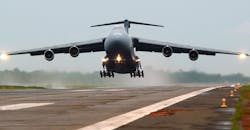Air Force Uses 3D-Printed Parts on Transport Planes
After several weeks of printing, inspections, and component testing, the Air Force recently installed 17 3D-printed parts in both polymer and metal on a C-5 Galaxy transport jet in less than three days. The parts are used in various parts of the cabin and crew bunk areas of the plane and included overhead panels, reading and emergency light covers, window reveals, and gasper panels.
Aluminum seal-retention handles were also redesigned to take advantage of 3D printing (also known as additive manufacturing). Engineers redesigned the handles to be more ergonomically friendly, lighter, and more able to operate despite minor installation variations. They also reduced the build time and eliminated the two-tone, multi-coat paint scheme that has been used since the inception of the aircraft, continuing to drive cost down.
With average print times of 24 to 48 hours, plus paint application, keeping an eye on cost and reducing cycle times was critical.
Air Force engineers worked with the company that supplies the polymeric raw material to get the printed material to be “gunship grey,” so parts could be printed in the color required for the interior cabin. This eliminated the need for painting prior to installation.
Many of the parts that were replaced with their printed counterparts were not available for purchase or had long lead times. So using 3D printing may only take a couple of days to print parts instead of the weeks, months, or even years it takes to acquire parts through traditional measures.
In the near future, the Air Force planes to install at least 20 more polymer and metal printed components on the aircraft. Some will be made of titanium and other high strength alloys, driving the technology to the next level.
As the Air Force’s additive manufacturing library of parts continues to grow, the cost benefits of additive manufacturing production will increase.
The RSO estimates that future field production of just these 17 parts alone could save tens of thousands of dollars, at the same time improving part performance and continuing to improve aircraft readiness.

